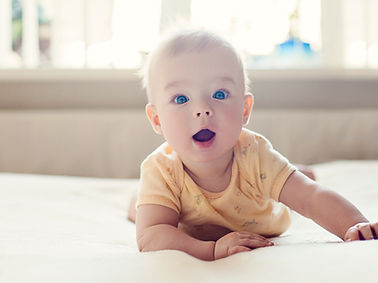
Milestones
Developmental milestones are key markers of growth and progress in various areas, including physical, cognitive, language, social, and emotional development. These milestones help parents and caregivers understand what to expect as children grow and when to seek support if needed. Tracking these milestones can provide valuable insights into your child's overall development.
It's important to note that the following list of milestones are an average time frame. Some babies reach these milestones a little before and some are little after and that's okay! Research has shown that intervention is likely to be more effective when it is provided earlier in life. You know your child best! Don’t wait if you have any concerns, your child is not meeting milestones or they have lost skills they once had. Talk with your child's pediatrician or give us a call at the office. We'd be happy to discuss your child's development and any concerns you may have! Continue reading for milestones from birth to 6 years of age. You can also track your child's milestones from age 2 months to 5 years with CDC's easy-to-use checklists using the following link:
Newborn - 2 months

During the first two months of life, newborns experience rapid growth and development. At around one month, babies begin to focus on faces and briefly lift their head while lying on their stomach. Babies move their arms and legs in preparation for walking. Movements are quite jerky but they will get smoother as your baby grows. They have strong reflexes demonstrated by turning a cheek when touched, sucking, and grasping your finger. They mostly keep their hands in a fist, are able to bring their hands to/near their mouth, and enjoy looking at high contract images. They also start to turn their heads towards familiar sounds and voices.
By two months, babies start to smile socially, make cooing sounds, and can hold their head up for longer periods. Their reflexes start to disappear and their movements become more purposeful. They enjoy looking at colorful patterns and can recognize familiar objects. They may start to smile when you smile at them or smile spontaneously.
These early milestones are crucial as they lay the foundation for further cognitive and physical development.
3 - 5 months
At 3 to 5 months, babies typically reach several exciting developmental milestones. They begin to show improved head control, allowing them to hold their heads steady while sitting. They open and close their hands, bring toys to their mouth, grasps toys, and start to become aware of cause and effect. They are able to raise their head and chest when lying on tummy, push up on their elbows and hands while on their belly as well as track moving objects with their eyes. Socially, they start to smile at people and may even laugh, showcasing their growing social awareness. Additionally, babies may begin to push down on their legs when their feet touch a hard surface and show an interest in reaching for toys, enhancing their hand-eye coordination.

6 months

At six months, babies typically reach several key developmental milestones. They can usually sit up with minimal support and may roll more easily in both directions. They rake objects into their palm using their fingers, transfers objects between hands, visually track a falling object, enjoy rhythmic movements (bouncing/rocking), and look briefly for a toy that has been dropped. Socially, they become more interactive, showing excitement during playtime and recognizing familiar faces. They often begin to babble, giggle, and imitate single sounds ('mah' and 'dah'), laying the groundwork for future language development.
7 - 9 months
Between 7 to 9 months, babies may start to sit without support, crawl, pull to stand, bang toys together, and clap their hands. They start feeding themselves and show an emerging pincer grasp (using thumb and index finger). They are able to point using their index finger, find partially hidden objects, and play using their arms (peek a boo). They are able to purposefully release toys into containers with large openings. Many babies will respond to their names, imitate patterns of speech, wave bye-bye, and babble chains of consonants ('mamama' or 'dadada'). You might notice them experimenting with sounds, babbling more frequently, and even beginning to understand simple words like 'no and 'bye-bye'.


10 - 12 months
Between 10 to 12 months, babies may start to stand without support and take their first steps, showing a growing sense of independence. Communication skills also increase with many babies saying simple words "mama" or "dada'. They have increased focus and attention and are able to understand basic commands. They become more curious of their environment by crawling or cruising along furniture and may show preferences for certain toys or people.The start to manipulate objects by pushing/pulling, turning/twisting, and opening/closing. The are getting better at feeding themselves, recognize themselves in the mirror, and can sit from a standing position.